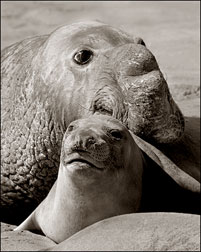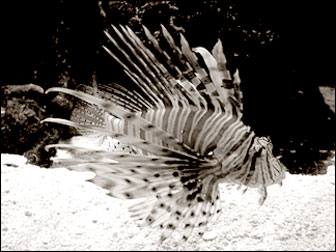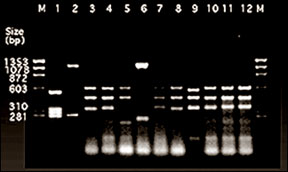Genetic screening for wildlife conservation
by Sajitha Prematunge
[email protected]

Northern elephant seal |

Cheetah |

Lion fish |
|

Genetic fingerprint
|
Genetic diverisity is one of the major factors that determine
survival of species. As it ensures the resistance against epidemics,
diseases and other natural crisis and assures that, in the face of a
catastrophe, at least few individuals of a species will live on to
reproduce and pass on their genes to the next generation. Consequently
genetical information on any species is vital for their conservation.
According to Wikpedia DNA fingerprinting, otherwise known as DNA
profiling, is a method of identifying different individuals of the same
species, by way of analyzing their DNA.
Although the DNA sequence of different individuals of the same
species are quite similar, DNA fingerprinting uses a DNA profiling,
which exploits highly variable repeat sequences called VNTRs (Variable
Number Tandem Repeats). DNA is extracted and the molecules are
electrically charged, to derive a 'DNA fingerprint'.
DNA testing is used in Forensic science for identifying suspects by
matching blood, hair, saliva and semen samples. But the significance of
DNA fingerprinting for conservation efforts, is still largely
unexplored, specially in countries like Sri Lanka.
Dr. Devaka Weerakoon Senior Lecturer University of Colombo says that
Genetic screening can be used in Biodiversity management, not only to
determine the conservation method, but to determine which species need
conservation the most.
Genetic screening is the best method for identifying whether a
certain species is heterogenous or homogenous. The higher the diversity
greater the chance of survival.
Steps could be taken to ensure the protection of species with lower
genetic diveristy, however large they are in number. The genetic
diversity of threatened species could be monitored via continuous
genetic screening.
Genetic diversity and Population of species run parallel. Threatened
species have the least diversity and whatever feasible conservation
action plans depend on their status of genetic diversity. Conservation
does not merely mean preserving their numbers.
Although this was the belief among the scientists earlier, the
radical decline in the genetic diversity of animals like Cheetahs,
Northern Elephant Seals and Lion Fish resulted in a drastic drop of
numbers. It was evident that these animals were suffering from what's
termed as 'Genetic bottleneck'.
This phenomenon occurs when the population of a certain species is
subject to rapid decline, mostly due to overhunting. As a result of
inbreeding genetic variation within the population inevitably declines,
causing their gene pool to shrink further.
Northern Elephant Seals, population fell to about 30 in the 1890s.
Cheetahs are so closely related to each other that skin grafts from one
cheetah to another do not provoke immune responses, thus suggesting an
extreme population bottleneck.(Web: Understanding Evolution)
'Genetic drift' is the evolutionary process of change in the gene
frequencies of a population from one generation to the next. A smaller
population has a slimmer chance at survival as a species because they do
not have a gene pool divers enough to withstand drastic environmental
changes.
Consequently the whole species would be wiped out in the face of an
environmental catastrophe. According to conservation biology the chances
of survival of species with extreme low genitic diversity are very low.
Through genetic screening any conservation method from cross breeding
with wild species of the same kind or captive individuals, translocation
and interbreeding species of different habitats, in order to facilitate
the gene flow, if the populations are isolated can be considered.
Dr. Devaka Weerakoon, explains that some are sceptical about such
measures as genetic screening - to the point that it has reached the
level of phobia - because they seem to be repelled by the very term
'genes' because of bio piracy.
Samantha Gunasekera Chief preventive officer, Department of Customs
explained that there are two methods of smuggling biological resources -
bio-theft and bio-piracy. bio-theft refers to a loss in quantity where
as bio-piracy results in a qualitative loss.
Medicinal plants as well as endangered animal species such as
ornamental fish are often smuggled out of the country. Salacia
reticulata and Pantius Bandula (Black ruby barb) are smuggled for their
special characteristics. Any one could get a patent for a genetic
modification of these species or chemical extracted from these species.
"Countries that provide patents for these products claim that the
extraction of these material are done with indigenous, unwritten
knowledge or knowledge that is not science based.
Thereby justifying their conduct, as invaluable species like
Allamanda cathartica, Momordica charantia, Binara species (Exacum spp.),
Cinnamon and butterflies like Crimson rose are smuggled out of the
country and the products that are derived from some of the species are
given patents." As a result our country is loosing a lot of assets.
But "Bio piracy and genetic screening are completely different." said
Dr. Weerakoon. He further explained that refraining from conducting any
genetic research would be like refraining from hiring cashiers. "Genetic
samples can be misused. Cashiers also have the option of steeling money.
But that's no reason to stop hiring cashiers. It's an ethical issue.
There should be a proper system and policy, with necessary
guidelines. People who have access to genetic material should be
properly monitored, but not discouraged." He sees the reluctance to
conduct genetic research as a drawback in the field of conservation in
Sri Lanka.
Moreover he explained that most scientists do not follow accurate
methodology. "But ignorance is not an excuse. They should either be
aware or be made aware by authoritative associations such as NSF
(National Science Foundation) and Sri Lanka Association for Advancement
of Science." He reiterated the fact that the process should be
uncomplicated, in order to instill enthusiasm for genetic research.
He pointed out that conservation of resources alone will not be
beneficial. There is no harm in putting resources to some kind of use as
long as it is nonconsumptive. Referring to Salacia reticulata (Kotalahimbutu)
and other related species, he explained "We could either wait for the
technology to develop in our country or we could utilize the resource
with the aid of foreign technology."
He said that waiting until the technology developed it self, would
risk the emergence of substitute for the products derived out of these
species that could be of immense economical value to our country.
"We always follow the precautionary method, however if there is no
proper channel, people will always resort to illegal measures.
No matter how strict the laws may be, technology is such that our
genetic resources would somehow find their way out of our country." Dr.
Weerakoon indicated that the best counter measure would be awareness
rather than mere enforcement of law. |
